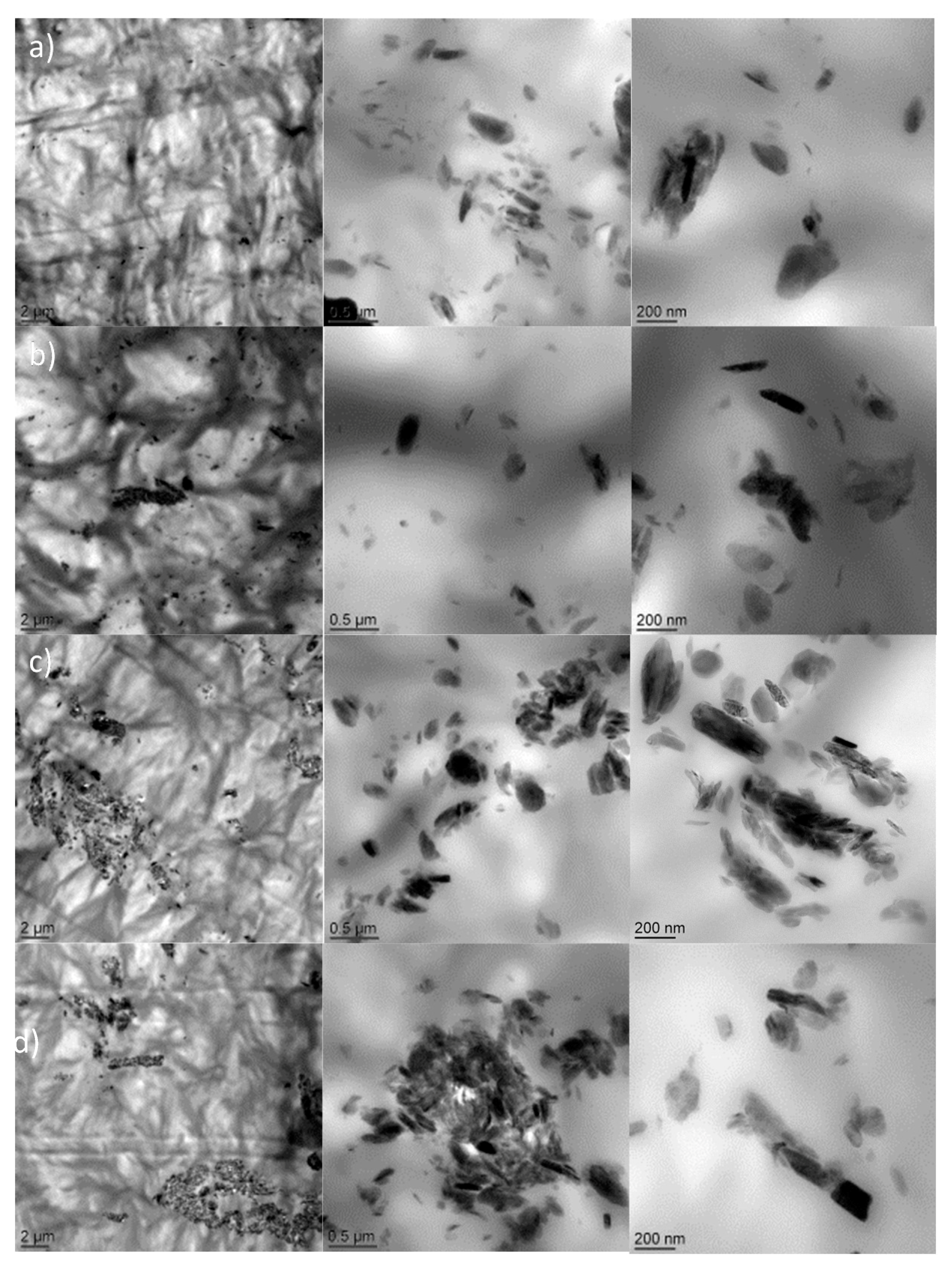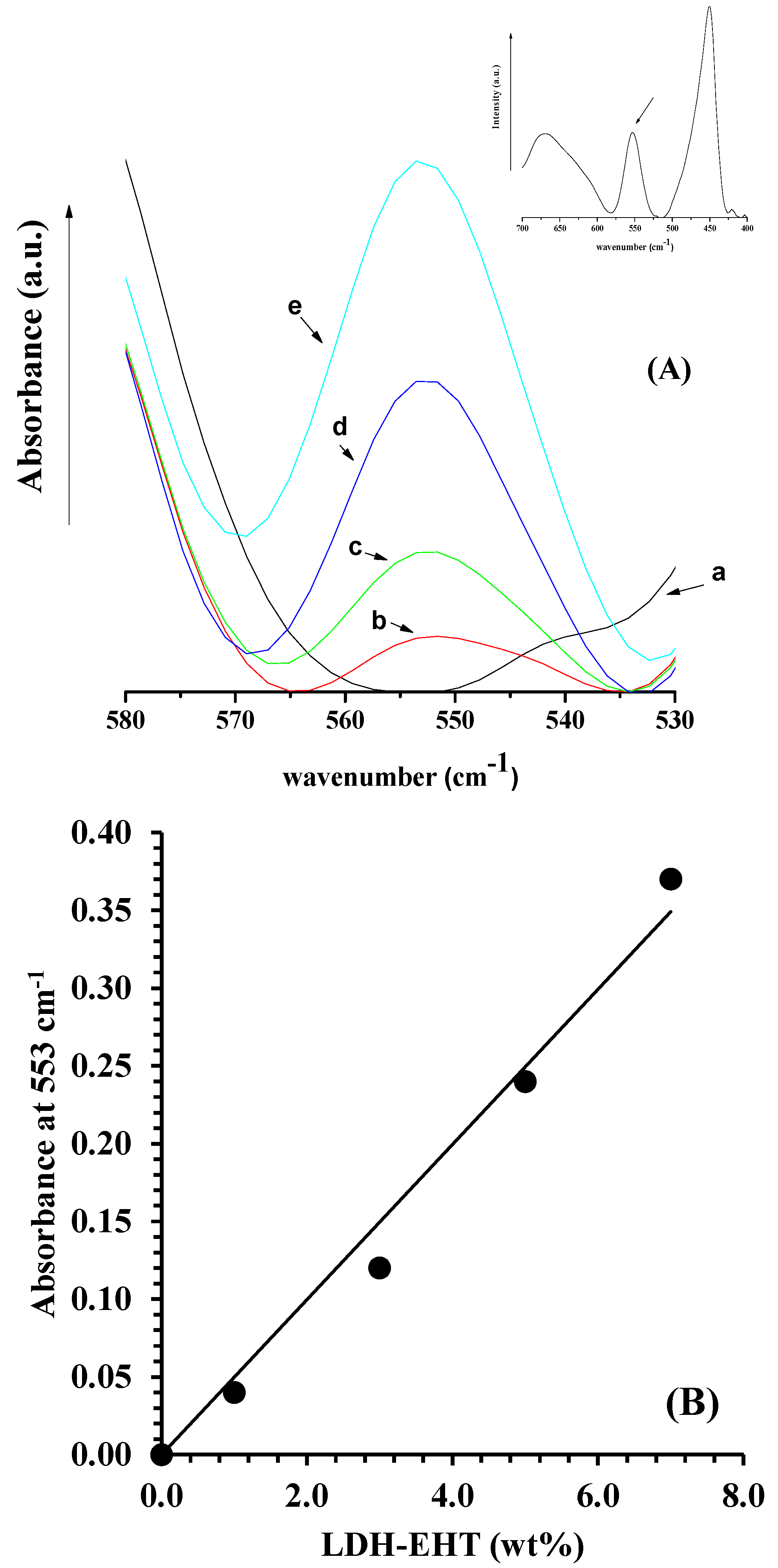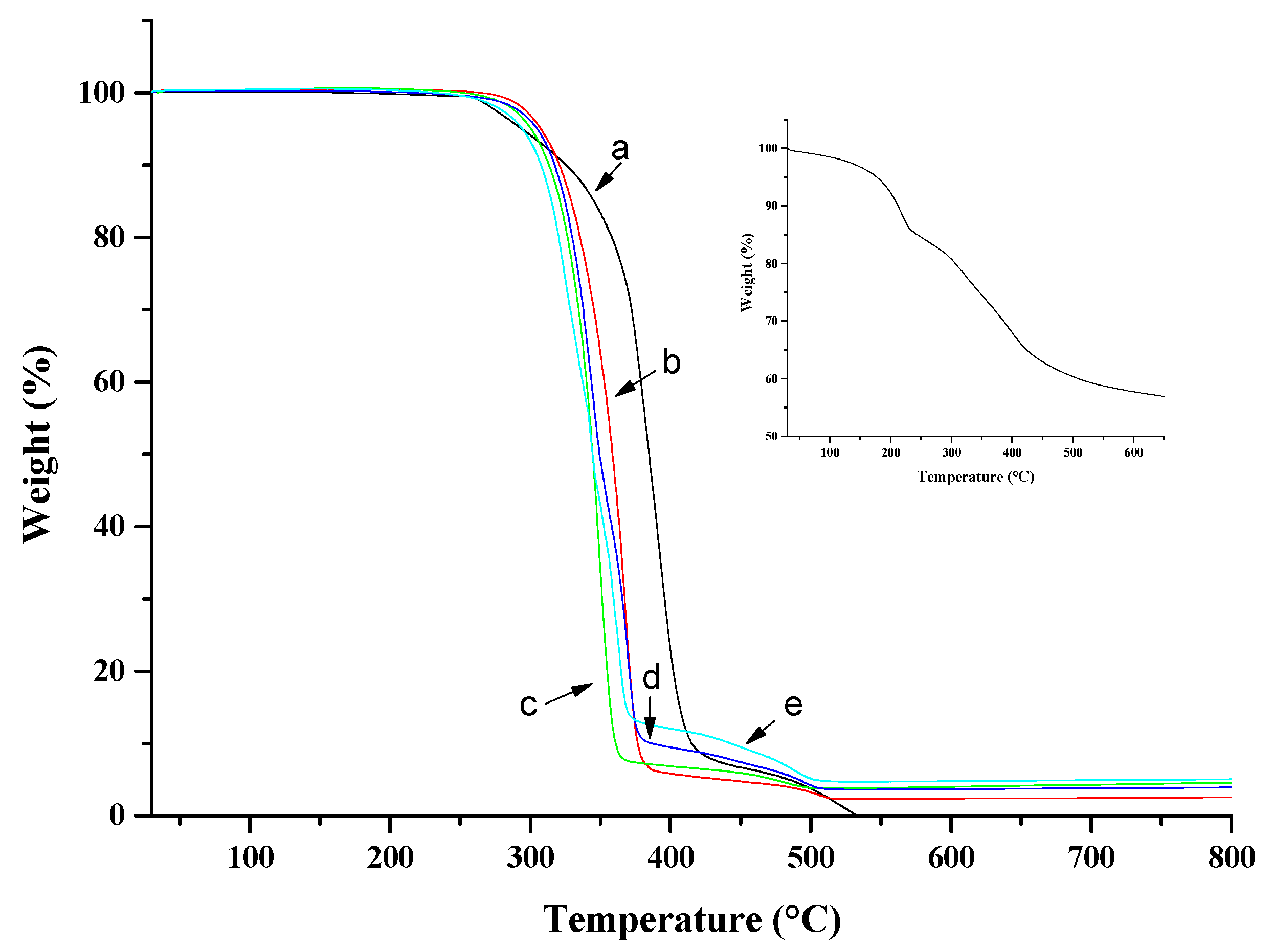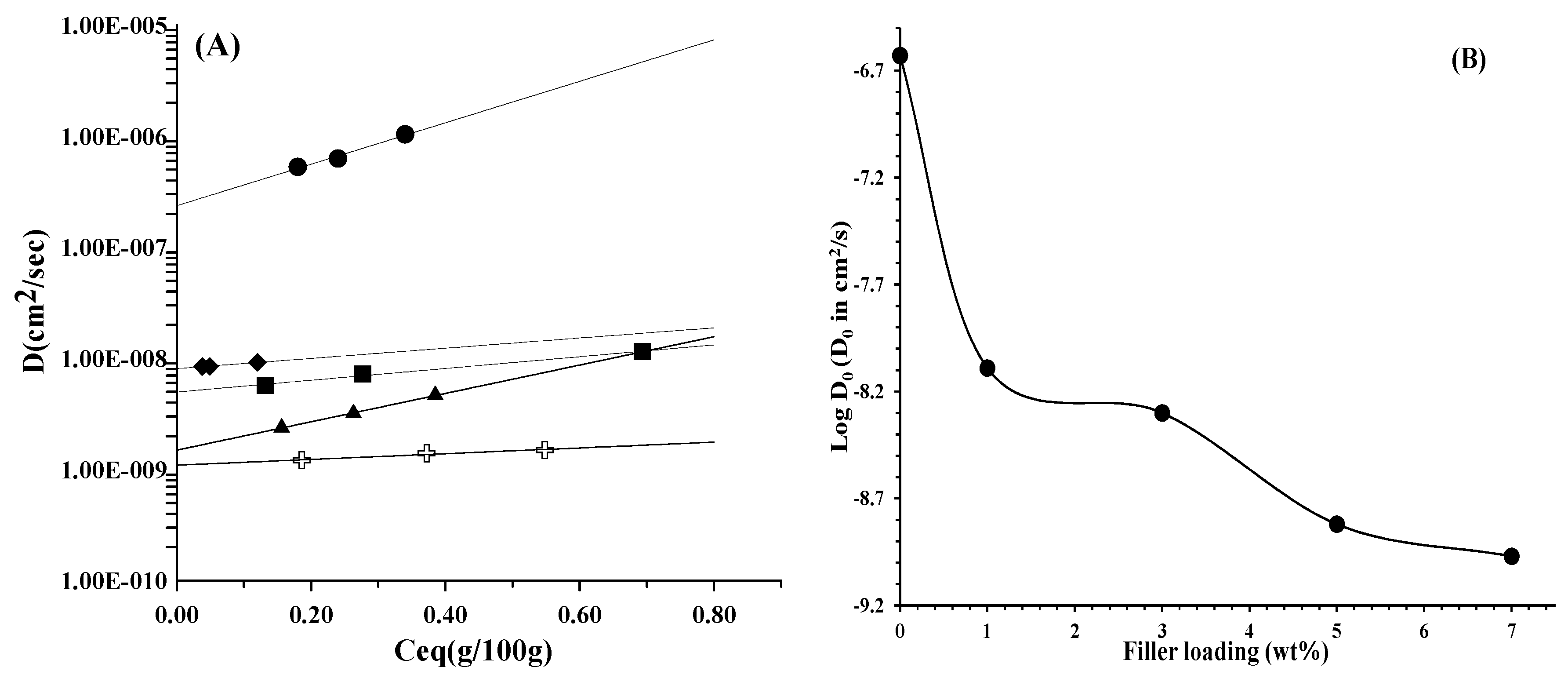Ionic Liquid as Surfactant Agent of Hydrotalcite: Influence on the Final Properties of Polycaprolactone Matrix
Abstract
:1. Introduction
2. Experimental
2.1. Materials
2.2. LDH-Ionic Liquid Preparation
2.3. Composite Films Preparation
2.4. Methods of Investigation
3. Results and Discussion
3.1. Morphologies of PCL/LDH Nanocomposites
3.2. Thermal Properties of PCL/LDH Nanocomposites
3.3. Surface Analysis and Transport Properties of PCL/LDH Nanocomposites
4. Concluding Remarks
Acknowledgments
Author Contributions
Conflicts of Interest
References
- Costantino, U.; Ambrogi, V.; Perioli, L.; Nocchetti, M. Hydrotalcite-like compounds: Versatile layered hosts of molecular anions with biological activity. Microporous Mesoporous Mater. 2008, 107, 149–160. [Google Scholar] [CrossRef]
- Costantino, U.; Bugatti, V.; Gorrasi, G.; Montanari, F.; Nocchetti, M.; Tammaro, L.; Vittoria, V. New Polymeric Composites Based on Poly(ε-caprolactone) and Layered Double Hydroxides Containing Antimicrobial Species. ACS Appl. Mater. Interfaces 2009, 16, 668–677. [Google Scholar] [CrossRef] [PubMed]
- Bugatti, V.; Costantino, U.; Gorrasi, G.; Nocchetti, M.; Tammaro, L.; Vittoria, V. Nano-hybrid incorporation into poly(ε-caprolactone) for multifunctional applications: Mechanical and barrier Properties. Eur. Polym. J. 2010, 46, 418–427. [Google Scholar] [CrossRef]
- Bugatti, V.; Gorrasi, G.; Montanari, F.; Nocchetti, M.; Tammaro, L.; Vittoria, V. Modified layered double hydroxides in polycaprolactone as a tunable delivery system: In vitro release of antimicrobial benzoate derivatives. Appl. Clay Sci. 2011, 52, 34–40. [Google Scholar] [CrossRef]
- Gorrasi, G.; Bugatti, V.; Vittoria, V. Pectins filled with LDH-antimicrobial molecules: Preparation, characterization and physical properties. Carbohydr. Polym. 2012, 89, 132–137. [Google Scholar] [CrossRef] [PubMed]
- Gorrasi, G.; Bugatti, V. Edible bio-nano-hybrid coatings for food protection based on pectins and LDH-salicylate: Preparation and analysis of physical properties. LWT Food Sci. Technol. 2016, 68, 139–145. [Google Scholar] [CrossRef]
- Gorrasi, G.; Bugatti, V. Mechanical dispersion of layered double hydroxides hosting active molecules in Polyethylene: Analysis of structure and physical properties. Appl. Clay Sci. 2016, 132, 2–6. [Google Scholar] [CrossRef]
- Choudary, B.M.; Lakshmi, M.K.; Venkat, C.R.R.; Koteswara, K.R.; Figueras, F. The first example of Michael addition catalyzed by modified Mg–Al hydrotalcite. J. Mol. Catal. A Chem. 1999, 146, 279–284. [Google Scholar] [CrossRef]
- Guida, A.; Lhouty, M.H.; Tichit, D.; Figueras, F.; Geneste, P. Hydrotalcites as base catalysts. Kinetics of Claisen-Schmidt condensation, intramolecular condensation of acetonylacetone and synthesis of chalcone. Appl. Catal. A Gen. 1997, 164, 251–264. [Google Scholar] [CrossRef]
- EI-Toufaili, F.A.; Ahmadniana, F.; Dinse, A.; Feix, G.; Reichert, K.-H. Studies on hydrotalcite-catalyzed synthesis of poly(ethylene terephthalate). Macromol. Mater. Eng. 2006, 291, 1136–1143. [Google Scholar] [CrossRef]
- Pavan, P.C.; Crepaldi, E.L.; Valim, J.B. Sorption of anionic surfactants on layered double hydroxides. J. Colloid Interface Sci. 2000, 229, 346–352. [Google Scholar] [CrossRef] [PubMed]
- Crepaldi, E.L.; Tronto, J.; Cardoso, L.P.; Valim, J.B. Sorption of terephthalate anions by calcined and uncalcined hydrotalcite-like compounds. Colloids Surf. A Physicochem. Eng. Asp. 2002, 211, 103–114. [Google Scholar] [CrossRef]
- Iyi, N.; Matsumoto, T.; Kaneko, Y.; Kitamura, K. Deintercalation of carbonate ions from a hydrotalcite like compound: Enhanced decarbonation using acid–salt mixed solution. Chem. Mater. 2004, 16, 2926–2932. [Google Scholar] [CrossRef]
- Lei, Z.; Chen, B.; Koo, Y.; MacFarlane, D.R. Introduction: Ionic Liquids. Chem. Rev. 2017, 117, 6633–6635. [Google Scholar] [CrossRef] [PubMed]
- Huddleston, J.G.; Visseer, A.E.; Reichert, M.W.; Willauer, H.D.; Broker, G.A.; Rogers, R.D. Characterization and comparison of hydrophilic and hydrophobic room temperature ionic liquids incorporating the imidazolium cation. Green Chem. 2001, 3, 156–164. [Google Scholar] [CrossRef]
- Weyershausen, B.; Lehmann, K. Industrial application of ionic liquids as performance additives. Green Chem. 2005, 7, 15–19. [Google Scholar] [CrossRef]
- Zhao, H.; Malhotra, S.V. Applications of ionic liquids in organic synthesis. Aldrichim. Acta 2002, 35, 75–83. [Google Scholar] [CrossRef]
- Howlett, P.C.; Zhang, S.; Macfarlane, D.R.; Forsyth, M. An investigation of a phosphinate-based ionic liquid for corrosion protection of magnesium alloy AZ31. Aust. J. Chem. 2007, 60, 43–46. [Google Scholar] [CrossRef]
- Rahman, M.; Brazel, C.S. Effectiveness of phosphonium, ammonium and imidazolium based ionic liquids as plasticizers for poly(vinyl chloride): Thermal and ultraviolet stability. In Polymer Preprints (American Chemical Society; Division of Polymer Chemistry), Proceedings of the 227th ACS National Meeting, Anaheim, CA, USA, 28 March–1 April 2004; American Chemical Society: Washington, DC, USA; Volume 45, pp. 301–302.
- Park, K.; Xanthos, M. A study on the degradation of polylactic acid in the presence of phosphonium ionic liquids. Polym. Degrad. Stab. 2009, 94, 834–844. [Google Scholar] [CrossRef]
- Livi, S.; Bugatti, V.; Soares, B.G.; Duchet-Rumeau, J. Structuration of ionic liquids in a poly(butylene-adipate-co-terephtalate) matrix: Influence on the water vapour permeability and mechanical properties. Green Chem. 2014, 16, 3758–3762. [Google Scholar] [CrossRef]
- Livi, S.; Pham, T.N.; Gérard, J.-F.; Duchet-Rumeau, J. Polymer and Ionic Liquids: A successful wedding. Macromol. Chem. Phys. 2015, 216, 359–368. [Google Scholar] [CrossRef]
- Livi, S.; Bugatti, V.; Marechal, M.; Soares, B.G.; Duchet-Rumeau, J.; Barra, G.M.O.; Gérard, J.-F. Ionic Liquids-Lignin combination: An innovative way to improve mechanical behaviour and water vapour permeability of eco-designed biodegradable polymer blends. RSC Adv. 2015, 5, 1989–1998. [Google Scholar] [CrossRef]
- Lins, L.; Livi, S.; Duchet-Rumeau, J.; Gérard, J.-F. Phosphonium ionic liquids as new compatibilizing agents of biopolymer blends composed of poly(butylene-adipate-co-terephtalate)/poly(lactid acid) (PBAT/PLA). RSC Adv. 2015, 5, 59082–59092. [Google Scholar] [CrossRef]
- Livi, S.; Duchet-Rumeau, J.; Pham, T.N.; Gérard, J.-F. A comparative study on different ionic liquids used as surfactants: Effect on thermal and mechanical properties of high density polyethylene nanocomposites. J. Colloid Interface Sci. 2010, 349, 424–433. [Google Scholar] [CrossRef] [PubMed]
- Livi, S.; Duchet-Rumeau, J.; Gérard, J.-F. Supercritical CO2—Ionic liquids mixtures for modification of organoclays. J. Colloid Interface Sci. 2011, 353, 225–230. [Google Scholar] [CrossRef] [PubMed]
- Livi, S.; Duchet-Rumeau, J.; Pham, T.N.; Gérard, J.-F. Synthesis and physical properties of new surfactants based on ionic liquids: Improvement of thermal stability and mechanical behaviour of high density polyethylene nanocomposites. J. Colloid Interface Sci. 2011, 354, 555–562. [Google Scholar] [CrossRef] [PubMed]
- Livi, S.; Dufour, C.; Gaumont, A.-C.; Levillain, J. Influence of the structure of the onium iodide salts on the properties of modified montmorillonite. J. Appl. Polym. Sci. 2013, 127, 4015–4026. [Google Scholar] [CrossRef]
- Bonnet, L.G.; Kariuki, B.M. Ionic liquids: Synthesis and characterization of triphenylphosphonium tosylates. Eur. J. Inorg. Chem. 2006, 2, 437–446. [Google Scholar] [CrossRef]
- Bradaric, C.J.; Downard, A.; Kennedy, C.; Robertson, A.J.; Zhou, Y. Industrial preparation of phosphonium ionic liquids. Green Chem. 2003, 5, 143–152. [Google Scholar] [CrossRef]
- Ha, J.U.; Xanthos, M. Functionalization of nanoclays with ionic liquids for polypropylene composites. Polym. Compos. 2008, 30, 534–542. [Google Scholar] [CrossRef]
- Calderon, J.U.; Lennox, B.; Kamal, M.R. Polystyrene/phosphonium orgarnoclay nanocomposites by melt compounding. Int. Polym. Process. 2008, 1, 119–128. [Google Scholar] [CrossRef]
- Kredatusova, J.; Benes, H.; Livi, S.; P-Georgievski, O.; Ecorchard, P.; Pavlova, E.; Bogdal, D. Influence of ionic liquid-modified LDH on microwave-assisted polymerization of ε-caprolactone. Polymer 2016, 100, 86–94. [Google Scholar] [CrossRef]
- Livi, S.; Lins, L.; Peter, J.; Benes, H.; Kredatusova, J.; Donato, R.K.; Pruvost, S. Ionic Liquids as Surfactants for Layered Double Hydroxide Fillers: Effect on the Final Properties of Poly(butylene adipate-co-terephthalate). Nanomaterials 2017, 7. [Google Scholar] [CrossRef] [PubMed]
- Lins, L.C.; Bugatti, V.; Livi, S.; Gorrasi, G. Phosphonium ionic liquid as interfacial agent of layered double hydroxide: Application to a pectin matrix. Carbohydr. Polym. 2018, 182, 142–148. [Google Scholar] [CrossRef] [PubMed]
- Livi, S.; Bugatti, V.; Estevez, L.; Duchet-Rumeau, J.; Giannelis, E.P. Synthesis and physical properties of Layered Double Hydroxide based on Ionic Liquids: Application to a Polylactide matrix. J. Colloid Interface Sci. 2012, 388, 123–129. [Google Scholar] [CrossRef] [PubMed]
- Livi, S.; Bugatti, V.; Hayrapeytan, S.; Wang, Y.; Estevez, L.; Vittoria, V.; Giannelis, E.P. Deposition of LDH on plasma treated polylactid acid to reduce water permeability. J. Colloid Interface Sci. 2013, 396, 47–52. [Google Scholar]
- Owens, D.K.; Wendt, R.C. Estimation of the surface free energy of polymers. J. Appl. Polym. Sci. 1969, 13, 1741–1747. [Google Scholar] [CrossRef]
- Lagaly, G.; Fernandez Gonzalez, M.; Weiss, A. Problems in Layer-Charge Determination of Montmorillonites. Clay Miner. 1976, 11, 173–187. [Google Scholar] [CrossRef]
- Favre, H.; Lagaly, G. Organo-bentonites with quaternary alkylammonium ions. Clay Miner. 1991, 26, 19–32. [Google Scholar] [CrossRef]
- Kloprogge, J.T.; Frost, R.L. Fourier Transform Infrared and Raman Spectroscopic Study of the Local Structure of Mg-, Ni-, and Co-Hydrotalcites. J. Solid State Chem. 1999, 146, 506–515. [Google Scholar] [CrossRef]
- Persenaire, O.; Alexandre, M.; Degée, P.; Dubois, P. Mechanisms and Kinetics of Thermal Degradation of Poly(ε-caprolactone). Biomacromolecules 2001, 2, 288–294. [Google Scholar] [CrossRef] [PubMed]
- Sorrentino, A.; Gorrasi, G.; Tortora, M.; Vittoria, V.; Costantino, U.; Marmottini, F.; Padella, F. Incorporation of Mg–Al hydrotalcite into a biodegradable Poly(ε-caprolactone) by high energy ball milling. Polymer 2005, 46, 1601–1608. [Google Scholar] [CrossRef]
- Fan, Y.; Nishida, H.; Mori, T.; Shirai, Y.; Endo, T. Thermal degradation of poly(l-lactide): Effect of alkali earth metal oxides for selective l,l-lactide formation. Polymer 2004, 45, 1197–1205. [Google Scholar] [CrossRef]
- Motoyama, T.; Tsukegi, T.; Shirai, Y.; Nishida, H.; Endo, T. Effects of MgO catalyst on depolymerization of poly-l-lactic acid to l,l-lactide. Polym. Degrad. Stab. 2007, 92, 1350–1358. [Google Scholar] [CrossRef]
- Ha, J.U.; Xanthos, M. Novel modifiers for layered double hydroxides and their effects on the properties of polylactic acid composites. Appl. Clay Sci. 2010, 47, 303–310. [Google Scholar] [CrossRef]
- Carvalho, P.J.; Neves, C.M.S.S.; Coutinho, J.A.P.J. Surface tensions of bis (trifluoromethylsulfonyl) imide anion-based ionic liquids. J. Chem. Eng. Data 2010, 55, 3807–3812. [Google Scholar] [CrossRef]
- Almeida, H.F.D.; Lopes-da-Silva, J.A.; Freire, M.G.; Coutinho, J.A.P. Surface tension and refractive index of pure and water-saturated tetradecyltrihexylphosphonium-based ionic liquids. J. Chem. Thermodyn. 2013, 57, 372–379. [Google Scholar] [CrossRef]
- Nguyen, T.K.L.; Livi, S.; Soares, B.G.; Benes, H.; Gérard, J.-F.; Duchet-Rumeau, J. Toughening of epoxy/ionic liquid networks with thermoplastics based on poly(2.6-dimethyl-1,4-phenylene ether) PPE. ACS Sustain. Chem. Eng. 2017, 5, 1153–1164. [Google Scholar] [CrossRef]
- Koros, W.J.; Burgess, S.K.; Chen, Z. Polymer Transport Properties. Encycl. Polym. Sci. Technol. 2015. [Google Scholar] [CrossRef]
- Freire, M.G.; Carvalho, P.J.; Fernandes, A.M.; Marrucho, I.M.; Queimada, A.J.; Coutinho, J. Surface tensions of imidazolium based ionic liquids: Anion, cation, temperature and water effect. J. Colloid Interface Sci. 2007, 314, 621–630. [Google Scholar] [CrossRef] [PubMed]




 ); and (B) the log D0 as function of filler (LDH-EHT) loading (wt %).
); and (B) the log D0 as function of filler (LDH-EHT) loading (wt %).
 ); and (B) the log D0 as function of filler (LDH-EHT) loading (wt %).
); and (B) the log D0 as function of filler (LDH-EHT) loading (wt %).
| Ionic Liquid | Chemical Structure | Code |
|---|---|---|
| Trihexyl(tetradecyl)phosphonium 2-ethylhexanoate |  | EHT |
| Sample | T10%weight loss (°C) | T50%weight loss (°C) |
|---|---|---|
| PCL | 327 | 385 |
| PCL + 1% LDH-EHT | 320 | 359 |
| PCL + 3% LDH-EHT | 315 | 343 |
| PCL + 5% LDH-EHT | 317 | 348 |
| PCL + 7% LDH-EHT | 307 | 344 |
| Sample | θwater (°) | θCH2I2 (°) | Surface Energy (mN/m) | Dispersive Component (mN/m) | Polar Component (mN/m) |
|---|---|---|---|---|---|
| PCL | 77 ± 3 | 62 ± 0.4 | 30.8 | 26.1 | 4.7 |
| PCL + 1% LDH-EHT | 113 ± 11 | 62 ± 2.4 | 31.6 | 31.2 | 0.4 |
| PCL + 3% LDH-EHT | 106 ± 3 | 52 ± 1.8 | 33.1 | 32.3 | 0.8 |
| PCL + 5% LDH-EHT | 87 ± 4 | 49 ± 0.5 | 33.2 | 31.0 | 2.2 |
| PCL + 7% LDH-EHT | 85 ± 3 | 50 ± 3.6 | 33.5 | 30.2 | 3.3 |
© 2018 by the authors. Licensee MDPI, Basel, Switzerland. This article is an open access article distributed under the terms and conditions of the Creative Commons Attribution (CC BY) license (http://creativecommons.org/licenses/by/4.0/).
Share and Cite
Lins, L.C.; Bugatti, V.; Livi, S.; Gorrasi, G. Ionic Liquid as Surfactant Agent of Hydrotalcite: Influence on the Final Properties of Polycaprolactone Matrix. Polymers 2018, 10, 44. https://doi.org/10.3390/polym10010044
Lins LC, Bugatti V, Livi S, Gorrasi G. Ionic Liquid as Surfactant Agent of Hydrotalcite: Influence on the Final Properties of Polycaprolactone Matrix. Polymers. 2018; 10(1):44. https://doi.org/10.3390/polym10010044
Chicago/Turabian StyleLins, Luanda Chaves, Valeria Bugatti, Sébastien Livi, and Giuliana Gorrasi. 2018. "Ionic Liquid as Surfactant Agent of Hydrotalcite: Influence on the Final Properties of Polycaprolactone Matrix" Polymers 10, no. 1: 44. https://doi.org/10.3390/polym10010044





